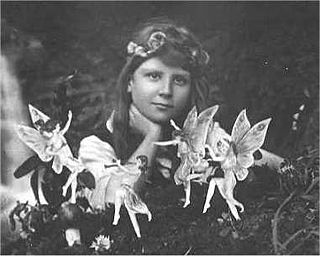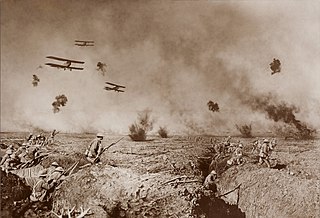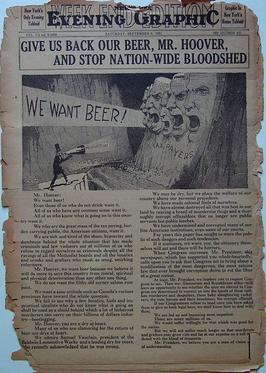
The Cottingley Fairies appear in a series of five photographs taken by Elsie Wright (1901–1988) and Frances Griffiths (1907–1986), two young cousins who lived in Cottingley, near Bradford in England. In 1917, when the first two photographs were taken, Elsie was 16 years old and Frances was 9. The pictures came to the attention of writer Sir Arthur Conan Doyle, who used them to illustrate an article on fairies he had been commissioned to write for the Christmas 1920 edition of The Strand Magazine. Doyle, as a spiritualist, was enthusiastic about the photographs, and interpreted them as clear and visible evidence of psychic phenomena. Public reaction was mixed; some accepted the images as genuine, others believed that they had been faked.

Photomontage is the process and the result of making a composite photograph by cutting, gluing, rearranging and overlapping two or more photographs into a new image. Sometimes the resulting composite image is photographed so that the final image may appear as a seamless physical print. A similar method, although one that does not use film, is realized today through image-editing software. This latter technique is referred to by professionals as "compositing", and in casual usage is often called "photoshopping". A composite of related photographs to extend a view of a single scene or subject would not be labeled as a montage, but instead a stitched image or a digital image mosaic.

Five Star Final is a 1931 American pre-Code drama film about the excesses of tabloid journalism directed by Mervyn LeRoy and starring Edward G. Robinson, Aline MacMahon and Boris Karloff. The screenplay was by Robert Lord and Byron Morgan based on the 1930 play of the same name by Louis Weitzenkorn. The title refers to the practice of newspapers publishing a series of editions throughout the day, with their final-edition front page having five stars printed and the word "Final." "Five Star Final" is also a font introduced during World War I and then favored by newspapers for its narrow type.

Photojournalism is journalism that uses images to tell a news story. It usually only refers to still images, but can also refer to video used in broadcast journalism. Photojournalism is distinguished from other close branches of photography by having a rigid ethical framework which demands an honest but impartial approach that tells a story in strictly journalistic terms. Photojournalists contribute to the news media, and help communities connect with one other. They must be well-informed and knowledgeable, and are able to deliver news in a creative manner that is both informative and entertaining.

Photograph manipulation involves the transformation or alteration of a photograph. Some photograph manipulations are considered to be skillful artwork, while others are considered to be unethical practices, especially when used to deceive. Photographs may be manipulated for political propaganda, to improve the appearance of a subject, for entertainment, or as humor.

William Notman was a Scottish-Canadian photographer and businessman. The Notman House in Montreal was his home from 1876 until his death in 1891, and it has since been named after him. Notman was the first photographer in Canada to achieve international recognition.

The New York Daily Mirror was an American morning tabloid newspaper first published on June 24, 1924, in New York City by the William Randolph Hearst organization as a contrast to their mainstream broadsheets, the Evening Journal and New York American, later consolidated into the New York Journal American. It was created to compete with the New York Daily News which was then a sensationalist tabloid and the most widely circulated newspaper in the United States. Hearst preferred the broadsheet format and sold the Mirror to an associate in 1928, only to buy it back in 1932.

Cover art is a type of artwork presented as an illustration or photograph on the outside of a published product such as a book, magazine, newspaper (tabloid), comic book, video game, music album, CD, videotape, DVD, or podcast.

Bernarr Macfadden was an American proponent of physical culture, a combination of bodybuilding with nutritional and health theories. He founded the long-running magazine publishing company Macfadden Publications.

Photo identification or photo ID is an identity document that includes a photograph of the holder, usually only their face. The most commonly accepted forms of photo ID are those issued by government authorities, such as driver's licenses, identity cards and passports, but special-purpose photo IDs may be also produced, such as internal security or access control cards.
Rhinelander v. Rhinelander was a divorce case between Kip Rhinelander and Alice Jones. Leonard "Kip" Rhinelander was an American socialite and a member of the socially prominent and wealthy New York City Rhinelander family. His marriage at the age of 21 to Alice Jones, a biracial woman who was a working-class daughter of English immigrants, made national headlines in 1924.
Jazz journalism was a term applied to American sensational newspapers in the 1920s. Focused on entertainment, celebrities, sports, scandal and crime, the style was a New York phenomenon, practiced primarily by three new tabloid-size daily newspapers in a fight for circulation. Convenient for readers on subways, the small-format papers were designed to display large page one photographs and headlines for newsstand sales. The tabloids' popularity was controversial, but also influenced the city's and nation's more traditional media, especially when columnist Walter Winchell became popular both in print and on the air.

The New York Evening Graphic was a tabloid newspaper published from 1924 to 1932 by Bernarr Macfadden. Exploitative and mendacious in its short life, the Graphic exemplified tabloid journalism and launched the careers of Walter Winchell, Louis Sobol, and sportswriter-turned-columnist and television host Ed Sullivan.
Sport was an American sports magazine. Launched in September 1946 by New York-based publisher Macfadden Publications, Sport pioneered the generous use of color photography – it carried eight full-color plates in its first edition.

There has been demand for imagery of nude celebrities for many decades. It is a lucrative business exploited by websites and magazines.

Arthur (Usher) Fellig, known by his pseudonym Weegee, was a photographer and photojournalist, known for his stark black and white street photography in New York City.
Macfadden Communications Group is a publisher of business magazines. It has a historical link with a company started in 1898 by Bernarr Macfadden that was one of the largest magazine publishers of the twentieth century.

Ghost Stories was an American pulp magazine that published 64 issues between 1926 and 1932. It was one of the earliest competitors to Weird Tales, the first magazine to specialize in the fantasy and occult fiction genre. It was a companion magazine to True Story and True Detective Stories, and focused almost entirely on stories about ghosts, many of which were written by staff writers but presented under pseudonyms as true confessions. These were often accompanied by faked photographs to make the stories appear more believable. Ghost Stories also had original and reprinted contributions, including works by Robert E. Howard, Carl Jacobi, and Frank Belknap Long. Among the reprints were Agatha Christie's "The Last Seance", several stories by H.G. Wells, and Charles Dickens's "The Signal-Man". Initially successful, the magazine began to lose readers and in 1930 was sold to Harold Hersey. Hersey was unable to reverse the magazine's decline, and publication of Ghost Stories ceased in early 1932.
Emile Gauvreau (1891-1956) was an American journalist, newspaper and magazine editor and author of novels and nonfiction books. He is best known as editor of two of New York's entertainment and sensation oriented "jazz age" tabloid newspapers.

Photographs have been taken in the area now known as Canada since 1839, by both amateurs and professionals. In the 19th century, commercial photography focussed on portraiture. But professional photographers were also involved in political and anthropological projects: they were brought along on expeditions to Western Canada and were engaged to document Indigenous peoples in Canada by government agencies.















